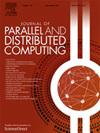To repair or not to repair: Assessing fault resilience in MPI stencil applications
IF 4
3区 计算机科学
Q1 COMPUTER SCIENCE, THEORY & METHODS
引用次数: 0
Abstract
With the increasing size of HPC computations, faults are becoming more and more relevant in the HPC field. The MPI standard does not define the application behaviour after a fault, leaving the burden of fault management to the user, who usually resorts to checkpoint and restart mechanisms. This trend is especially true in stencil applications, as their regular pattern simplifies the selection of checkpoint locations. However, checkpoint and restart mechanisms introduce non-negligible overhead, disk load, and scalability concerns. In this paper, we show an alternative through fault resilience, enabled by the features provided by the User Level Fault Mitigation extension and shipped within the Legio fault resilience framework. Through fault resilience, we continue executing only the non-failed processes, thus sacrificing result accuracy for faster fault recovery. Our experiments on some specimen stencil applications show that, despite the fault impact visible in the result, we produced meaningful values usable for scientific research, proving the possibilities of a fault resilience approach in a stencil scenario.
修复或不修复:评估MPI模板应用中的故障恢复能力
随着高性能计算计算规模的不断扩大,故障在高性能计算领域的应用越来越广泛。MPI标准没有定义发生故障后的应用程序行为,将故障管理的负担留给了用户,用户通常采用检查点和重启机制。这种趋势在模板应用程序中尤为明显,因为它们的常规模式简化了检查点位置的选择。但是,检查点和重新启动机制引入了不可忽略的开销、磁盘负载和可伸缩性问题。在本文中,我们通过故障恢复展示了另一种选择,它由用户级故障缓解扩展提供的特性支持,并在Legio故障恢复框架中提供。通过故障恢复,我们继续只执行未发生故障的进程,从而牺牲结果的准确性以实现更快的故障恢复。我们在一些样品模板应用上的实验表明,尽管在结果中可以看到故障影响,但我们产生了可用于科学研究的有意义的值,证明了模板场景中故障恢复方法的可能性。
本文章由计算机程序翻译,如有差异,请以英文原文为准。
求助全文
约1分钟内获得全文
求助全文
来源期刊

Journal of Parallel and Distributed Computing
工程技术-计算机:理论方法
CiteScore
10.30
自引率
2.60%
发文量
172
审稿时长
12 months
期刊介绍:
This international journal is directed to researchers, engineers, educators, managers, programmers, and users of computers who have particular interests in parallel processing and/or distributed computing.
The Journal of Parallel and Distributed Computing publishes original research papers and timely review articles on the theory, design, evaluation, and use of parallel and/or distributed computing systems. The journal also features special issues on these topics; again covering the full range from the design to the use of our targeted systems.
 求助内容:
求助内容: 应助结果提醒方式:
应助结果提醒方式:


